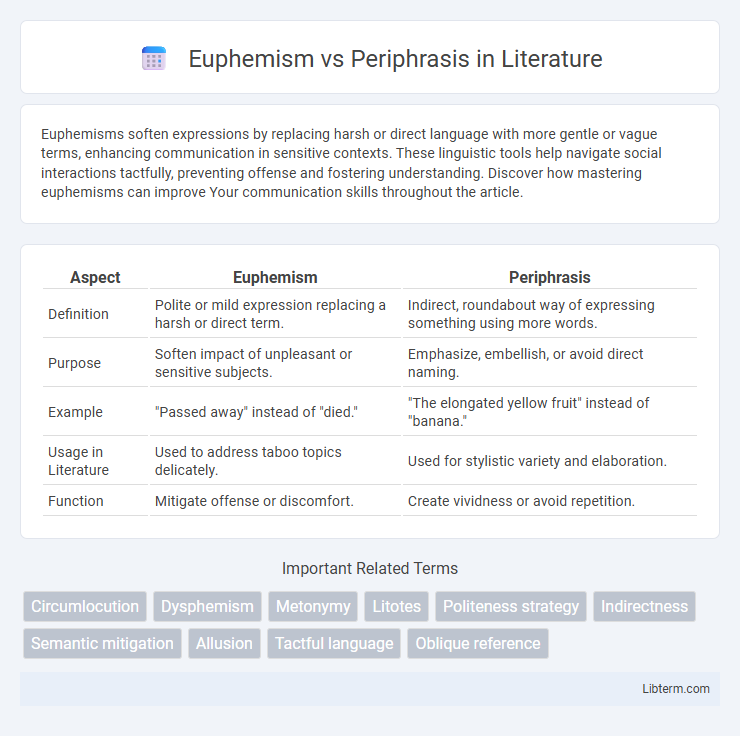Euphemisms soften expressions by replacing harsh or direct language with more gentle or vague terms, enhancing communication in sensitive contexts. These linguistic tools help navigate social interactions tactfully, preventing offense and fostering understanding. Discover how mastering euphemisms can improve Your communication skills throughout the article.
Table of Comparison
| Aspect | Euphemism | Periphrasis |
|---|---|---|
| Definition | Polite or mild expression replacing a harsh or direct term. | Indirect, roundabout way of expressing something using more words. |
| Purpose | Soften impact of unpleasant or sensitive subjects. | Emphasize, embellish, or avoid direct naming. |
| Example | "Passed away" instead of "died." | "The elongated yellow fruit" instead of "banana." |
| Usage in Literature | Used to address taboo topics delicately. | Used for stylistic variety and elaboration. |
| Function | Mitigate offense or discomfort. | Create vividness or avoid repetition. |
Understanding Euphemism: Definition and Purpose
Euphemism involves substituting a mild or indirect term for one that may be harsh, blunt, or offensive, serving to soften communication and reduce discomfort. Its primary purpose is to address sensitive topics such as death, bodily functions, or taboo subjects with greater politeness and social acceptability. Unlike periphrasis, which uses longer or more elaborate expressions to describe something, euphemism specifically aims to mitigate negative emotional responses or social awkwardness.
What is Periphrasis? A Clear Explanation
Periphrasis is a linguistic device that involves using multiple words to express a concept that could be conveyed with a single word, often to achieve emphasis or clarity. Unlike euphemism, which aims to soften or obscure unpleasant realities through indirect language, periphrasis expands description without necessarily altering the tone or intent. It is commonly employed in poetry, rhetoric, and everyday speech to add nuance, elaborate meaning, or avoid repetition.
Key Differences Between Euphemism and Periphrasis
Euphemism involves substituting a mild, indirect, or less offensive term for one considered harsh or blunt, often to soften unpleasant realities, while periphrasis uses multiple words to express an idea that could be conveyed with a single term, emphasizing descriptive or indirect expression. Euphemisms primarily serve to reduce discomfort or social taboo surrounding a topic, whereas periphrasis functions as a stylistic or rhetorical device enhancing clarity or emphasis. The key difference lies in their intent: euphemism aims to mitigate impact or offense, while periphrasis focuses on elaborate or roundabout expression.
Common Examples of Euphemism in Everyday Language
Common euphemisms in everyday language include phrases like "passed away" instead of "died," "let go" to mean being fired from a job, and "downsizing" referring to company layoffs. These softening expressions serve to reduce the emotional impact or social discomfort associated with direct terms. Euphemisms often replace harsh or unpleasant realities, making conversations more polite and socially acceptable.
Periphrasis in Literature and Speech
Periphrasis in literature and speech serves as a stylistic device that employs indirect, descriptive phrases to express ideas more vividly or tactfully, often replacing a single word with a longer expression. This technique enhances narrative richness and can convey subtle emotional or cultural nuances, making it particularly effective in poetic and rhetorical contexts. Unlike euphemism, which primarily softens harsh realities, periphrasis expands linguistic creativity and depth through elaborate circumlocution.
The Role of Euphemism in Sensitive Topics
Euphemism plays a crucial role in addressing sensitive topics by softening harsh or uncomfortable expressions, making conversations more socially acceptable and less likely to offend. It facilitates communication around subjects such as death, bodily functions, and taboo behaviors by substituting direct language with gentler or more ambiguous terms. This linguistic strategy helps maintain politeness, reduce emotional distress, and navigate cultural norms in both personal and professional contexts.
How Periphrasis Shapes Communication Style
Periphrasis shapes communication style by employing longer, more elaborate expressions instead of concise terms, which enhances formality and subtlety in discourse. This technique often introduces a rhythmic and measured tone, allowing speakers to emphasize politeness or soften statements without altering meaning. By expanding simple ideas into descriptive phrases, periphrasis enriches language complexity and influences how messages are perceived and interpreted.
Psychological Effects of Euphemism Use
Euphemisms soften the impact of harsh or uncomfortable realities, reducing anxiety and emotional distress by providing a more palatable expression for sensitive topics. This linguistic strategy can facilitate social interactions by minimizing embarrassment and preserving face, but excessive use may lead to denial or avoidance of critical issues. Psychological research indicates that while euphemisms help manage negative emotions temporarily, overreliance can hinder emotional processing and authentic communication.
When to Use Periphrasis vs Euphemism
Use periphrasis when aiming to elaborate or explain a concept with multiple words for clarity or emphasis, especially in formal or literary contexts. Euphemism is appropriate when intending to soften or obscure harsh, sensitive, or taboo subjects to maintain politeness or avoid offense. Selecting between periphrasis and euphemism depends on whether the goal is to clarify meaning or to mitigate potential discomfort in communication.
Euphemism and Periphrasis: Impact on Clarity and Tone
Euphemism softens harsh or sensitive topics by using mild or indirect expressions, which can enhance politeness but may reduce clarity by obscuring the true meaning. Periphrasis uses longer, more elaborate phrases instead of concise terms, often adding stylistic nuance but sometimes leading to vagueness and verbosity. Both linguistic strategies affect tone and comprehension, with euphemism typically creating a gentler, less confrontational atmosphere while periphrasis can either enrich or complicate communication depending on context.
Euphemism Infographic

 libterm.com
libterm.com